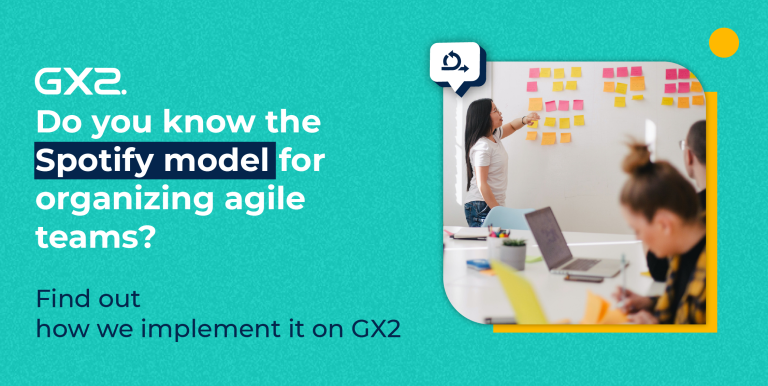Spotify’s agile methodology emerged to control their platform’s production and maintenance processes, but the division of teams has become quite famous and other companies, including GX2, are already taking inspiration and using it.
Por isso, vamos entender o que é, quais são as vantagens e como implementamos aqui na GX2:
The basic organization of the methodology is the matrix with vertically and horizontally oriented teams.
1. Vertical (squads and tribes)
The grouped by-product, that is, by features or groups of correlated features.
>> Squads are the basic unit of organization of teams, usually around a feature, or a subsection of a feature.
- May have 3 to 10 members.
- To develop everything from conception to prototyping, design, development, and deployment, the product aspects must be autonomous to the extent that they contain expertise within the group.
>> Tribe is the second level of grouping, and can contain a number of squads that have similar functionality and objectives. A tribe’s squads are physically close to each other so there is fluid communication.
- The maximum size of a tribe follows the Dunbar number limitation, ie around 100 people.
- Tribe member squads meet periodically to synchronize their efforts, present their work, and exchange experiences.
2. Horizontal (chapters and guilds)
Grouped by skill or interest, aiming to exchange best practices, experiences and challenges.
>> Chapter is a horizontal group (thus oriented by function/affinity) that brings together professionals with similar responsibilities and skills.
- Chapters are often contained within tribes, and meet frequently to exchange ideas, best practices, and challenges they are facing.
- In the chapter, there is a leader, who serves as a “technician” and guides the learning and functional development of the members.
>> Guilds, or guild, is a group of professionals, which can be from different squads and tribes, who come together to exchange experiences, learning, and best practices on topics of common interest.
- In many cases, the guild is made up of correlated chapters, for example, the Diversity & Inclusion Group, which add “aggregates” from other areas that have a common interest in the topic.
- Guilds usually have coordinators, who lead the topics to be discussed and organize the meetings.
Leading figures
As they are highly self-managed, there are no such outstanding formal leadership figures in teams, but more organic leaders, heavily grounded in the technical/functional aspects of the work.
Thus, only chapters and squads have clearly identified leadership.
- PO (product owner)/PM (product manager) directs what is done (WHAT)
- Chapter leader directs how this is done (HOW)
What are the advantages of applying this methodology?
Proof of the success of this strategy are the benefits this approach has brought to Spotify and other corporations that have invested in it:
>> Agility in decision making
One of the aspects is the agility in decisions. Consider, for example, an old, departmental and not agile structure: for every decision, it is necessary to wait bureaucratically for managers and leaders, who are often not in direct contact with what is happening on a daily basis. In squads, choices are made at the local level, by the leader focused on the functionality and responsibility of the group.
This change generates agility and speed for teams to be able to work and deliver quality results. Everything flows more quickly, without bureaucracy and communication bottlenecks. The groups work independently and simultaneously in order to help satisfy internal demands.
The methodologies chosen and the technologies vary a lot depending on the group, which generates an interesting diversity and allows the collaborator to contribute with the best, working with what is convenient for him.
>> Collaboration and learning among members
Another big advantage of this method is that it doesn’t lock people into closed groups only.
Unlike other alternatives, professionals remain connected with different people in the company, with the ability to collaborate and learn from each one of them. Members communicate with their squad, tribe, chapter and guild in order to extract knowledge from these levels.
Especially in guilds, which are specifically geared towards learning and the intellectual evolution of employees.
>> Flexibility and scalability
Spotify’s idea was to develop a framework that would keep the agile pillars alive, and they did it. Squads optimize internal flexibility, making the company adaptable to different levels of demand, especially with the assessment of their own methods. In addition, it is easier to grow in a safe and efficient way by adding new members to the organization.
In this way, the company remains competitive and modern, by valuing agile ideals and optimizing production speed.
Managing projects with agile methodologies is a big step towards efficiency and organization in companies. Based on this choice, it is possible to better manage deadlines, costs, personnel and even possible risks.
–
Support source: https://blog.smartconsulting.com.br/spotify-squads/
